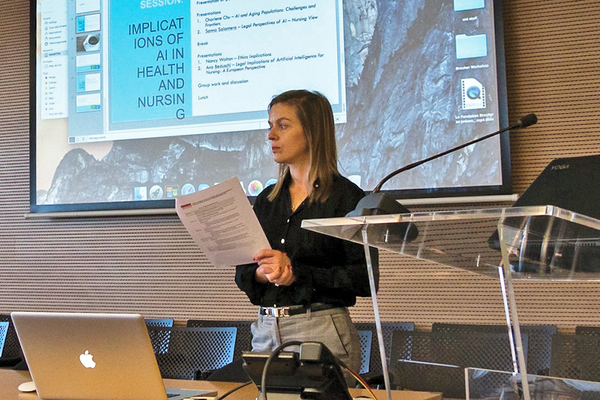Reducing the burden of stroke in African American communities
Research seeks to build trust, improve stroke knowledge
November 3, 2021
Brett Stursa

From left, Susan Everson-Rose, Clarence Jones, Zachary Taylor, Emily Gorcyski, Niloufar Hadidi, James Desota and Makeda Zulu.
As both a researcher focused on strokes and an advanced practice nurse, Niloufar Hadidi, PhD, APRN, CNS-BC, FAHA, knows that even with advances in risk factor identification and management, cardiovascular health disparities persist among African Americans.
Strokes are identified as the largest contributor to disparities in life expectancy in African Americans. In Minnesota, the death rate from stroke is 26% higher in African Americans compared to whites.
To address those disparities, Hadidi is partnering with Community Health Strategist Clarence Jones, MEd, CPH, CPE, CHW, of the Hue-MAN Partnership to build trust and improve understanding of stoke risk factors and warning signs. Their project, Building trust and reducing the burden of stroke in African-American communities, was awarded a community health collaborative pilot grant from the Clinical and Translational Science Institute.
“This community-academic partnership will build trust, explore strategies to engage African American communities around promoting stroke risk factor reduction and further explore barriers to behavioral change and solutions to overcoming stroke disparities,” says Hadidi.
The new research builds on the knowledge Hadidi gained over the years while volunteering at community health fairs. “We’ve had a stroke table, and with students, we take blood pressures and talk about warning signs of a stroke and risk factors,” says Hadidi. “We saw a higher rate of hypertension and that there is a major gap in general knowledge of a stroke.”
Initially, the research team will conduct surveys to gain a better understanding about what is known about risk factors and warning signs. Along with surveys, the first phase of the study includes virtual focus groups, called community listening circles. “We will listen to the community to understand where they are coming from, where they are getting their information, and what the best way is to get them accurate information,” says Hadidi.
The information will help inform a feasibility study to develop and refine a seven-week intervention based on American Health Association Life’s Simple 7, which are seven modifiable risk factors, like blood sugar, activity, cholesterol and diet.
Stroke Champions will be identified in the community, who will be trained on stroke warning signs and risk factors to share that information in the community.
The research team includes Doctor of Nursing Practice (DNP) students in the adult gerontological clinical nurse specialist specialty. “These DNP students have been integral to the project from the beginning. Oftentimes we think of an adult gero CNS in the hospital doing tertiary prevention, but there is no reason they can’t be leaders in the community providing primary prevention,” says Hadidi.
She adds that nurses are well-suited to lead these types of research projects. “I think we have a good combination of trust and knowledge that lends itself to this kind of research,” she says.
Once this study is completed, Hadidi plans to share what they’ve learned. “Every research answers some questions and brings up new questions,” says Hadidi. “We want to continue building that trust. We want to establish that this intervention is feasible and is it acceptable. Once we know that, we can bring it to a larger community.”


